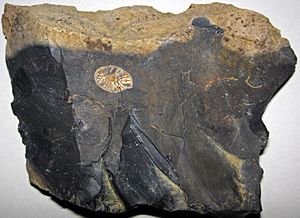Welling site facts for kids
Quick facts for kids Welling site |
|
|---|---|
| Lua error in Module:Location_map at line 420: attempt to index field 'wikibase' (a nil value). | |
| Location | Nellie, Coshocton County, Ohio |
The Welling site is a very old place where scientists found tools from the first people in North America. These people, called Paleo-Indians, lived a long, long time ago. The site is in Coshocton County, Ohio. It was a special spot where early humans got stone to make tools. Scientists think it was also a meeting place. People gathered here to learn how to make tools, share food, and meet others.
Discovering the Welling Site
The Welling site is located near the town of Nellie, Ohio. It sits in the Walhonding River Valley in Ohio. This area is known for its special rock called Upper Mercer flint. This flint was very important to ancient people. They used it to make strong stone tools.

The site was found by Carrell Welling in the early 1960s. He discovered two flint tools near his home. Later, in 1965, a team from Case Institute of Technology started digging at the site. They found many amazing things.
Tools and Artifacts
At the Welling site, archaeologists found many different tools. Most of these tools were made from the local Upper Mercer flint. Some tools were finished and ready to use. Others were still being made, like a workshop. This shows that people were making tools right there.
They found 54 "fluted points." These are special spear points from the Paleo-Indian period. They also found tools from a later time, called the Archaic period. These included different kinds of arrowheads.
Scientists also found tools used for many daily tasks. These tools helped with hunting and preparing food. They were used for cutting meat, scraping animal hides, and working with wood or bone.
Early Paleo-Indian Life
The earliest tools found at Welling are from about 12,000 BC. This was a time when huge animals like mastodons roamed the land. The Welling site was a key place for these early people. They came here to get the best stone for their tools.
Scientists studied the tools very closely. They looked at tiny marks on them, called "microwear." This showed how the tools were used. It helped them understand what daily life was like at the Welling site.
A Meeting Place
The Welling site was more than just a tool-making factory. It was a place where different groups of Paleo-Indians could meet. When people needed stone for tools, they would travel to places like Welling. This gave them a chance to interact with others.
People could learn new ways to make tools, like the complex Clovis fluted points. They could also share information, trade goods, and even find partners from other groups. It was a busy and important social hub for these ancient communities.


